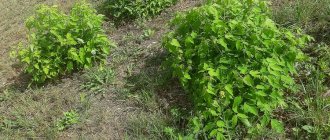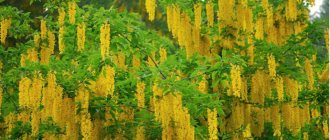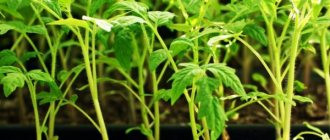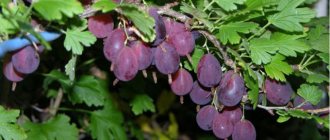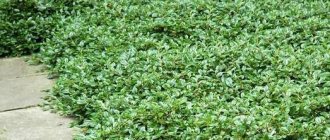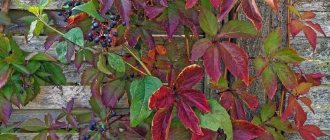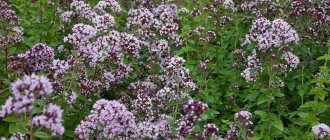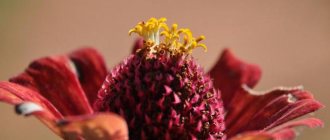Description
The variegated flamingo maple does not grow very tall like other types of maples. Its maximum height and crown diameter rarely exceed 5 meters. The tree reaches adult size by 20 years. Its crown is round and not too thick.
Maple grows quite quickly, growing in height and width at the same speed - up to 50 cm per year. The flamingo maple is a long-liver, but only by human standards. In favorable conditions it lives from 60 to 100 years.
The flowers from which the winged seeds appear are small - up to 6 mm, yellow-green. The leaves are lanceolate, five- or seven-lobed, like those of the Canadian maple, 10-20 cm long, in spring they are pink, in summer they become variegated - white-green. By autumn they acquire a variegated white-yellow color.
Acer maple Flamingo
Acer maple Flamingo under the gaze of greenery lovers
In nature, the plant is found in Mongolia, China and Korea. However, since 1860, maple began to be grown in many countries, including Russia. The main thing is that the climatic conditions suit the tree. It does not require special care and can withstand cold weather wonderfully.
The ash-leaved maple received the exotic name “Flamingo” because of the original color of its young foliage. In early spring it has a pinkish color. During the hot season, the foliage fades and takes on a greenish-white hue. In autumn, after the first frost, the foliage puts on a yellow and red outfit.
The maximum height of an adult tree reaches approximately 5 m. It grows quite quickly. About half a meter per year. Under the supervision of experienced gardeners, the plant lives for about 100 years. Despite this, its branches often break. They cannot withstand strong winds or wet snow. The main reason is the fragility of wood. However, in early spring it secretes a liquid that is used in folk medicine.
Only young foliage has the original pink color. In order for it to appear every year, it is advisable to pinch the tops of the shoots in the summer.
Flowering of the Flamingo ash maple begins even before the appearance of new foliage. Modest male and female yellow buds grow on the branches. Their pleasant aroma and sweet nectar attracts many insects and bees. Therefore, the plant is considered a honey plant.
After 2 months, fruits form on the tree. They consist of 2 thin transparent wings. Between them there is a compacted base, inside of which there is one seed. Lionfish remain on the branches until next spring. They then break off and end up in the soil. Some of them germinate successfully, resulting in young seedlings appearing.
Flamingo in the garden
Variegated, multi-colored leaves, the color of which changes from spring to autumn, give the tree an unusual, decorative appearance, which is why the flamingo maple is a desirable inhabitant of gardens and parks. A tree with beautiful leaves perfectly replaces flowering plants, which poorly take root and poorly show their decorative properties in shaded places.
Since only young leaves are pink, to renew the color of the tree in the summer, the tops of the shoots are pinched, thus stimulating the growth of new shoots with pink leaves.
Flamingo maple can be used for single and group plantings, as well as for creating hedges. In a group it is planted at a distance of 1 to 2-3-5 meters, depending on the purpose of cultivation.
The low tree combines well with other shrubs and flowers, making a good background for low-growing plants in the foreground, and a base for climbing roses and other climbing plants.
The flamingo maple will look great in the center of a flower bed with annual flowers - petunias, pansies, begonias. And if there is no time to care for even such unpretentious flowers, the tree trunk circle can be covered with pebbles, decorative chips, and painted crushed stone.
What is a Variegated Flamingo?
Variegated maple (Acer negundo Flamingo) is a low-growing tree whose height rarely exceeds seven meters. The Flamingo is decorated with a fluffy crown, growing up to five meters in diameter, and covered with openwork foliage of a delicate pale pink or greenish-pinkish color.
The plant's homeland is North America, so it is not surprising that the tree is often called the American maple or Californian flamingo. Despite the fact that maple came to Europe from warm countries, it took root well in the middle zone, showing high frost resistance and unpretentiousness.
The California maple is distinguished not only by its high decorative value, but also by its rapid growth rate - from a young sprout it grows to an adult tree in 8-10 years, each year adding 50-60 cm in height.
The average lifespan of a Flamingo is 55-60 years. But some specimens can “live” until their centennial anniversary. This parameter is influenced by the low resistance of the plant to environmental influences: thin branches and a weak trunk can be broken by a strong wind. However, with proper care, Flamingo retains its attractive appearance throughout its entire life.
Interesting read: ash-leaved maple.
The main distinguishing features of the variegated Flamingo:
- Original coloring.
- Unusual foliage shape.
- Openwork crown.
- Reacts well to haircuts.
- Unpretentiousness to the composition of the soil.
- Resistant to temperature changes.
This exquisite tree can stand alone in a garden plot, or act as an ensemble with other plants.
Agricultural technology
Variegated maple is a light-loving plant. Insufficient illumination will negatively affect its leaves - their decorative effect will decrease, the leaves will lose their unusual color. Therefore, for planting it is necessary to select a bright, spacious place in which nothing will oppress the tree.
As for moisture and soil type, the flamingo maple has no special complaints here; it is not picky about these factors. The best soil acidity for this plant is pH 6.0-7.5.
It tolerates low and high temperatures equally well, but in dry summers it responds gratefully to abundant watering.
Planting and care do not take much time from gardeners. The hole is made in such a way that there is enough space for both the root system and the drainage layer, which is especially necessary if the groundwater lies too close.
120-150 grams of nitroammophoska are poured into the planting hole, a bucket of water is poured, the plant is installed and sprinkled with a mixture of peat, leaf soil and sand. And they pour another bucket of water into the hole.
In the second year after planting, in the spring, urea, potassium salts, and superphosphate are added to the soil. In the summer, simultaneously with watering and loosening, you need to add kemira.
During dry weather, water the pink maple once a week, pouring 20-30 liters of water under each tree. If it rains frequently, the number of waterings and the amount of water can be reduced.
The soil around the roots can be mulched with peat or sand, spreading a layer of 4-5 cm; in addition to retaining moisture, peat will become a good fertilizer for the tree.
The soil under the tree is loosened often, but not deeply, so as not to damage the roots. Weeds under young trees can be pulled out by hand.
In the summer, the flamingo maple must be sprayed with chemicals to kill mealybugs and whiteflies and weevils - these are the pests that most often damage the tree. Sometimes the plant is affected by diseases such as black spot and powdery mildew. For treatment and prevention, trees are sprayed with copper sulfate, infusions of garlic and tobacco, and chemicals.
Variegated maple in landscape design
Low flamingos are used to create various decorative compositions in a summer cottage. Here are just some variations:
- Hedge. A chic, bright pink maple can easily replace a fence, hiding the area from prying eyes with thick openwork foliage. They zone the garden, separating the agricultural area from the recreation area. They are also planted in combination with other trees. It complements coniferous plantings very well.
Maple partition
- Japanese corner. Another quite popular way to use maple in design. Blooming cherry trees will successfully replace fragrant sakura, and large peonies, hydrangeas, rhododendrons and azaleas will complement the landscape. Don't forget about accents. Japanese style assumes naturalness; avoid curbs, fences, and paved paths. They will be replaced by oddly shaped boulders and gravel. If it is possible to organize a small pond, place water lilies and water lilies in it. Even a short rest in such a place will restore strength and relieve fatigue.
- Flowerbed. The short and voluminous flamingo is used as a canopy for shade-loving plants. What to plant in this area depends only on the gardener’s imagination. These can be annual plants, which will change the appearance of the flower bed every year, or perennials. Blooming: lupins, peonies, lilies or herbaceous hosts, ferns or mosses. Or maybe it will be an individual combination of species? If caring for a flowerbed becomes tedious, it is always possible to disassemble it, mulch the area with peat or sand and place a relaxation area with a sun lounger or soft chair in the shade. This option will look beneficial both at the edge of the site and in the middle of the garden.
Maple in a flowerbed
- Color spot. If you want to divide the space with color, a flamingo is perfect for creating a pink and purple zone. His companions will be hyacinths, chrysanthemums, delicate geraniums and tuberose, as well as gorgeous dahlias.
Design
- Planting in tubs. A small tree is planted in a tub and used to decorate the entrance to the site, left in front of the house, and placed along the path. This method is often used to landscape entrances to administrative buildings, terraces and green corners on roofs where planting in the ground is not possible. When grown in a container, the life expectancy of maple is reduced, but, nevertheless, this option is also used for area decoration.
Thus, the possibilities for using the ash-leaved flamingo in design are quite extensive: from standard solutions - a hedge or a shady flowerbed - to extravagant ones: a Japanese roof patio.
Works in autumn
Young trees aged 1-2 years are prepared for winter in this way: the above-ground part is wrapped in burlap or agrofibre, the roots are sprinkled with peat, leaves, straw, and spruce branches.
It doesn’t matter if some branches freeze and die in winter - they are cut off in the spring so that new shoots will grow in their place and have time to get stronger before the next winter.
Wrapping for the winter is necessary only for trees aged 2-3 years; older specimens withstand the winter without needing insulation.
Planting and care, wintering
To plant an ash-leaf maple in the garden, you should prepare a hole measuring 50 by 50 by 70 cm, pouring 3 parts of humus, 2 parts of turf and 1 part of sand into it. In spring, for successful cultivation, it is necessary to fertilize the trees with a superphosphate-potassium-urea mixture in the amount of 100 g and the ratio: 2: 1: 2. Immediately after planting, each tree is filled with 15 liters of water, and weekly - 30 liters. In cool seasons, you can reduce the frequency of watering by 2-3 times.
To grow these trees you need to select fertile, loose and moist soil. To maintain the unique color, you should remove green shoots, and to maintain the shape of the plant, you need to cut it “down to the stump” every 3-4 years.
Preventative care for “coral spotting,” which often affects plants, consists of spraying maples with five percent vitriol “on dormant buds” and removing damaged branches. Caring for young trees that are not yet frost-resistant enough consists of wrapping them in spruce branches or double burlap near the roots, since the crown is not afraid of frost.
Trimming
Pruning is carried out in the spring, removing dried, diseased and damaged branches. Sometimes curly pruning is performed to give the crown one shape or another. To form a dense crown, you need to cut last year's growth by one third, to strong buds.
Regular pruning of flamingo maple has a beneficial effect on the size and color of the leaves - they become larger and acquire a more saturated color. In addition, having done pruning once, it will have to be done every year, since the crown will be too thick, disproportionately large and heavy for the trunk. As a result, it may break or bend. To prevent this, it is necessary to remove branches growing inside the crown, as well as other small and large shoots.
There is another benefit from spring pruning - the maple tree does not bloom after it, which means it does not disperse pollen and does not become an allergen for those who do not tolerate the flowering period well.
Biological features
This tree came to us from America; individual natural areas can be found in the Far East and in the swampy areas of Siberia. Most specimens look like wide and tall bushes, and not full-size trees. The average height is 5 meters, although there are also 7-meter maples.
Valued for its characteristic leaf color, which changes throughout the season. Large (10–20 cm) lanceolate leaves in spring are pink in color with white veins, which is how the variety got its name. In summer they darken, turning white-green, and in September the white background of the shoots gives way to yellow.
In the second half of May–early June, the time for flowering begins. At this time, medium-sized flowers (4–6 cm) are visible. They are distinguished by their pale yellow-green color and round, slightly flattened shape.
Reproduction
Maple with pink leaves is propagated by seeds or grafting. Under natural conditions, winged seeds scatter far due to their structure, take root and sprout without human help. In cultivation, they are sown in containers with soil, germinated, then planted in separate containers, and grown to such a size that they can be planted in open ground or used as a rootstock.
Flamingo maple cuttings are grafted onto stems 1.5-2 meters high, resulting in a new specimen with pink leaves and a round lush crown.
The best rootstock option for flamingo cuttings will be the original type, but in some cases other types of maple are also used, for example, Norway maple, which forms an even and strong trunk. If shoots with regular green leaves appear, they must be cut off immediately.
If you need to make a bush out of a plant, use low pruning, allowing numerous shoots to grow, or grafting in the area of the root collar of the rootstock. This is how the flamingo maple grows into an ornamental shrub.
Difficulties in growing
Despite the ease of propagation and the ability to quickly update or revitalize the garden interior, gardeners and landscape designers face some problems. For example, abundant maple flowering often causes allergic reactions. And shoots and self-seeding can turn an area into a small forest if the shoots are not removed in time.
maple pollen
Spring pruning of branches helps prevent problems with pollen. It has been noticed that pruned trees gain less color or do not bloom at all. The same method will also reduce the self-seeding of the plant. Don't be afraid to remove extra branches that grow into the tree or reach down to the ground, as lower branches like to use pincers to climb higher and attack their prey from the air. The maple crown will become even more magnificent after pruning.
The second problem is the rapidly developing root system. It is not recommended to plant maple in direct proximity to the asphalt surface in a populated area or to vegetable beds in a summer cottage. The distance to agricultural plantings is at least 2 meters. Maple roots destroy asphalt, so the best place for planting will be parks and green corners of at least 20 m₂.
Use in garden compositions
The combination of decorativeness and unpretentiousness has made maple a traditional element of landscape decor. It is often planted to add variety to a complex multi-species composition, although Flamingo can also act as the central element of a small decorative “bundle”.
Let's look at these options, starting with the simplest:
- Single planting surrounded by a flower bed.
The best “neighbors” are considered to be lobularia, petunias, pansies and begonias. They can be replaced with plants of similar size and color. - A separate pink and white “island” on the site.
The scheme is the same, but preference is given to flowers that fall in the same tone as the leaves. These could be dahlias and lilies, geraniums or delicate irises. To make such a corner look more natural, the maple is shifted slightly to the side - it is not advisable to place it strictly in the center, it slightly “hurts” the eye;
- Traditional mixborder.
As part of such a group, maples seem to set off their shorter “brothers” and flowers, so they are placed in the middle of the composition. If this happens in shaded areas, fern or lungwort are planted nearby. The fence obtained in this way can serve as both a boundary of the dacha and act as a wall separating the beds from the recreation area.
All these methods are good because you can use your imagination. With some effort, you will get impressive results pretty quickly. To make this task easier, let’s see what planting and further care look like in the case of the Flamingo maple variety.
